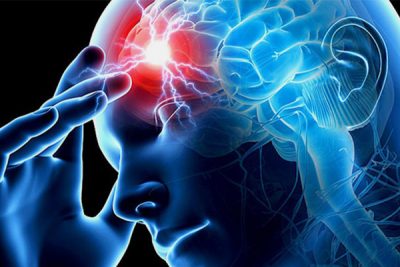WHEN A SMALL STROKE STRIKES
When I realized I had a small stroke, I panicked I might never be able to communicate with those I love most, or, even write again!
My speech was messed up. I could not read, write, or comprehend much. And, in my universe, I write, therefore I am!
But, I was lucky as most of my faculties were restored within 48 hours from the time I arrived in the Stroke Ward at St. Joseph Medical Center, Tacoma.
I do not remember much of the details other than it happened somewhere on the 5th hole at Lake Spanaway Golf Course in October (2019) with several old pals.
MY GAME WAS OFF AS USUAL
For some reason I could not hit the ball, I missed it by a mile – which is not uncommon for me, I am a horrible golfer.
However, it persisted, I was still not able to hit the ball even close. I remember trying six or more times but then decided to watch my friends complete the final nine holes rather than slow everyone up.
Conversation was difficult for me at that point, so I did not say much over the remaining holes and avoided saying anything.
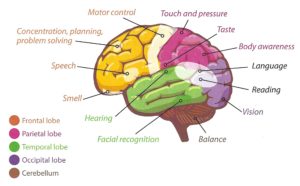 FORGOT MY NAME
FORGOT MY NAME
My friends insisted I stop at the restaurant in the club, at this point, as they could tell, my behavior was not right. I was having a hard time with my speech and comprehending what they were saying to me.
By the time the Medics arrived, I was thinking of leaving, but my friends and management at Lake Spanaway GC and Restaurant would not let me do so.
However, when I realized I could not remember my name or birth date for the ambulance Medic, I knew it was time to go with them.
I do not remember much about the ambulance ride, mostly the CT scan at the hospital, and was still disoriented, memory problems, and slurring speech.
‘YOU HAD A SMALL STROKE’
I first remember thinking I was recovering about the time I was admitted to my room in the Stroke Ward, shortly after the doctor confirmed my preliminary tests a couple of hours later. I had a small stroke in the frontal lobe.
At that point, the reality set in along with a few emotions, I was not sure what to expect or if there would be any long-term consequences. My main thought was I would never want to be a problem for my family or friends.
I ended up sleeping most the day and night at the hospital, also had an MRI, while they continued to bring down my high blood pressure that typically accompanies a stroke, they explained.
Of course, the MRI confirmed the small stroke, maybe a little bigger than first thought.
In short, I took a hit in the speech and reading area, possible language, and concentration areas. Though a big percentage of people have motor control over muscles, arms, face, etc. – but none of those was a problem for me.
MANY PEOPLE HAVE STROKES
I was lucky. According to the AHA, nearly 795,000 people have a stroke in the United States each year.
The majority of those strokes (610,000) are “first-time” strokes, and 137,000 are deaths. On average, someone dies of a stroke every 3.70 minutes – about 389.4 deaths from stroke each day (AHA 2016 data). And, of those first-time strokes, nearly 185,000 (roughly 30%) are most likely to have another stroke within five years.
It turns out the AHA says a stroke is a leading cause of death and disability in the United States for those 65 years or older (75%).
HIGHER RISK AT 65+
At 69, it looks like I was a prime candidate for a stroke and now have a higher chance of a repeat. If that’s the case, I need to continue taking care of my health and do a better job of recognizing when I am having a stroke. I also need to understand better what happens in stroke.
For starters, my stroke was an “Ischemic,” which makes up about 87% of most strokes, a “Hemorrhagic” stroke is around 13%. In general, the Ischemic occurs when a blood vessel supplying blood to the brain is obstructed.
Hemorrhagic strokes are caused by a weakened blood vessel, ruptures, or even an aneurysm, though high blood pressure is associated with all strokes, but specifically with the Hemorrhagic.
SEVERAL TYPES OF STROKES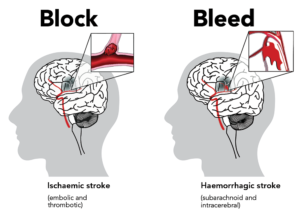
The American Stroke Association has several classifications for strokes, including a Transient Ischemic Attack (TIA), a “mini-stroke,” Cryptogenic Stroke, and Brain Stem Stroke.
Though age is the biggest factor in a stroke, African Americans have twice the risk as white people. Hispanic Americans and Indian/Alaska Americans are also higher than whites, but not as high as African Americans for risk.
Strokecenter.org also notes that men are most likely to have a stroke than a woman and the highest U.S. death rates are slightly higher in the Southeastern United States.
SEVERAL CONTRIBUTORS
Any of the following can easily increase your risk of a stroke:
- High Blood Pressure
- Diabetes
- Heart Disease
- Previous Stroke or TIA
- Cigarette Smoking
- High Cholesterol
- Too Much Alcohol
- Drug Abuse
- Overweight
- Lack of Exercise
- Being Pregnant
- Menopause
- Family History & Genetics
- Genetic Conditions
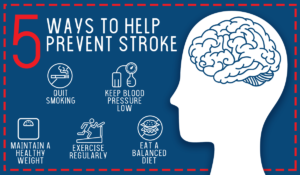 Unfortunately, I tick a lot of the boxes on the list, I’m over 65, have high blood pressure, diabetes, high cholesterol, and some bad genes I suspect.
Unfortunately, I tick a lot of the boxes on the list, I’m over 65, have high blood pressure, diabetes, high cholesterol, and some bad genes I suspect.
LUCKY I HAD MADE CHANGES
To my credit I have followed a strict diet and started a regular exercise routine since the first of the year (January 2019). I have lost 60 pounds and felt healthier than ever in the past 20 years, up until the stroke!
My doctor slowly even reduced some of the Type 2 diabetes and high-pressure blood medications in the past several months as well. My A1C blood sugar has never been better and blood pressure with great numbers for the past six months, specifically attributed to the weight loss.
I don’t smoke, drink, abuse drugs, sodas, processed foods, sugars, or treats. My normal meal is baked chicken and steamed vegetables or salad.
My doctor (Dr. Cory Sullivan, Hawkes-Prairie Family Medicine, Providence Health & Services) tells me I am in fairly good shape for my age and been a model patient in the past year, at least.
IT COULD HAVE BEEN WORSE
As he said, there is a good chance the stroke could have been much worse with the extra weight and higher blood pressure. I was packing only less than 12 months ago.
So, I will continue with my healthy diet and keep my weight down, as well as exercise as often as I can each day.
I know I need to do a better job of recognizing the symptoms of a stroke in the first place. The fact is, I did not realize or understand I was having a stroke until I was at the hospital. I need to recognize my symptoms instead of spending an hour denying I have a problem.
KNOW THE SYMPTOMS
That additional time makes a huge difference in helping your chance of greatly mitigating a stroke.
Before I left St Joseph’s, the nurses and therapist drummed into me the main stroke symptoms – FAST:
- Face drooping. Face typically droops on one side.
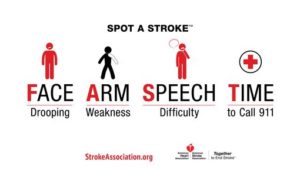
- Arm weakness. Hard to raise arm fully.
- Speech difficulties. Sluggish speech, inability to understand, or comprehend.
- Time to call emergency services. The sooner, the better.
And, again, the sooner you recognize you are having a stroke, the better chance you have of living through it.
TIME IS CRITICAL
Again, I consider myself extremely lucky that I was with good friends that saw I was not acting right and did not take my guff about not going to the hospital. And even luckier, I had a great hospital and medical services.
My chart is officially now noted as a CVA, “Cerebral Vascular Accident,” more specifically diagnosed as “Expressive Aphasia,” when a part of the brain that processes language is damaged.
ON THE MEND
It is amazing how quickly the brain can recover. I feel I am 95% to 98% as far as my speech, reading, and writing.
The speech therapist confirmed I have minor issues that can be corrected with some reading and talking exercises.
I also plan to continue with the healthy diet and regular exercise and working hard on my prescribed therapy – read, write, and talk as much as I can each day.
The good thing is I have an abundance of passion for each of these activities.
AUTHOR
Steve Kruse is a retired, former Pacific Northwest Journalist, Editor, and Publisher. He spent many years in computer technology in both Seattle and California, where he also managed some of the top youth baseball organizations the past 25 years.
© Steve Kruse 2019
